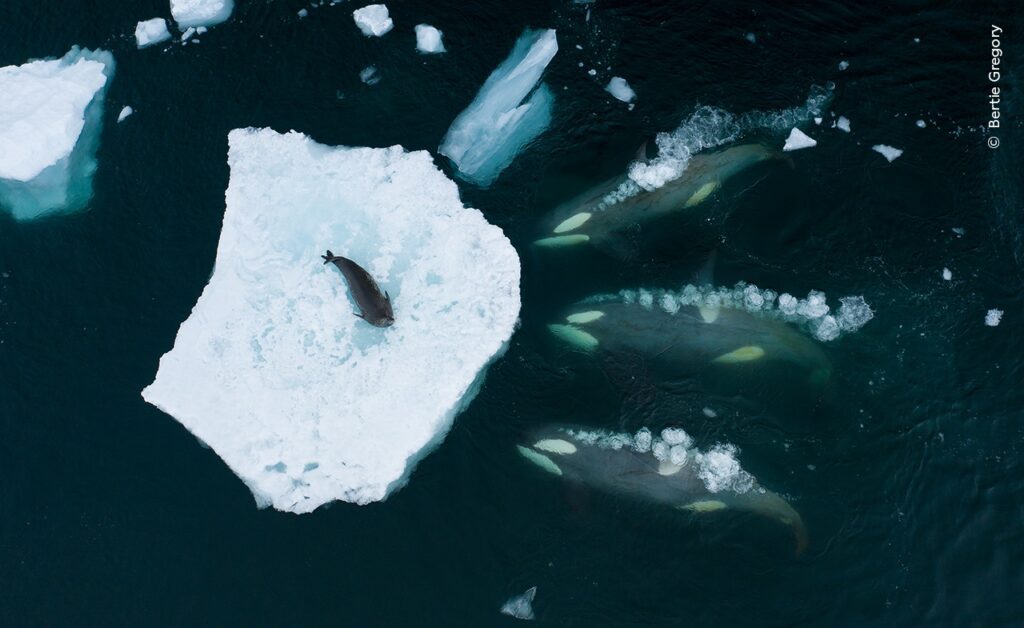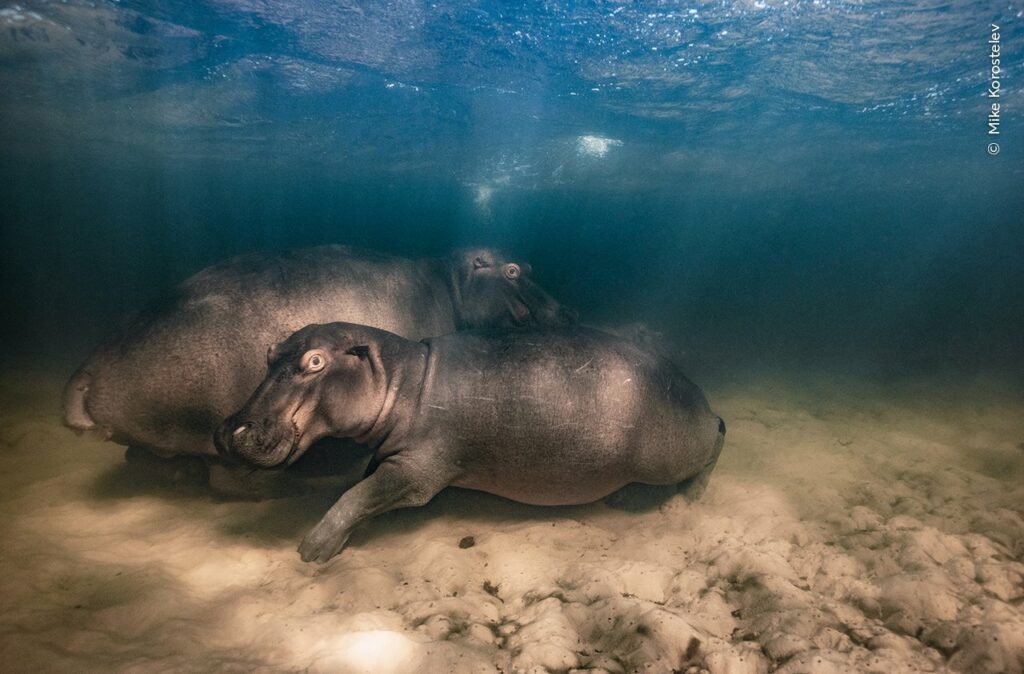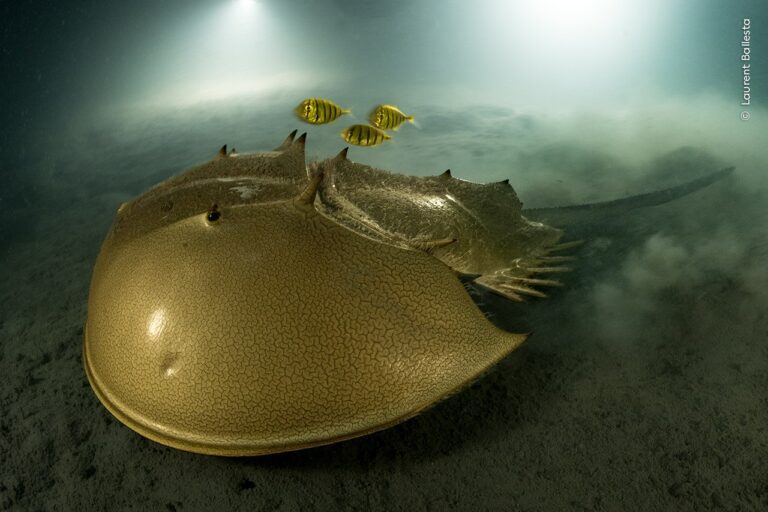French underwater photographer and marine biologist Laurent Ballesta was declared Wildlife Photographer of the Year 2023 last night (10 October) for his spectacular entry The Ancient Mariner, described as “an otherworldly image of a tri-spine horseshoe crab accompanied by a trio of golden trevallies”.
Ballesta is only the second photographer in the 59-year history of the prestigious competition to receive the Grand Title award twice.
The winners were announced at an awards ceremony in London’s South Kensington at the Natural History Museum (NHM), which developed and produces the competition. The exhibition featuring 100 placed images opens there this Friday (13 October) and runs through to next June. This year six of the 19 category winners had connections with the underwater world.
Ballesta first won the title in 2021 for his image of camouflage grouper in a cloud of eggs and sperm in French Polynesia, as reported on Divernet, and he scored again last year by winning the Portfolio award with his depiction of marine invertebrates under Antarctic ice. The Ancient Mariner was also a Portfolio category winner.
Over the years Ballesta has led a series of major expeditions involving scientific mysteries and diving challenges – and all resulting in unprecedented images, said the judges.
Also read: Pushing photo-shoot limits for new world record
The tri-spine horseshoe crab, its golden protective carapace concealing 12 appendages, has been around for more than 100 million years, though it now faces habitat destruction and overfishing for food and for its blue blood, which is used in the development of vaccines.
The protected waters of Pangatalan Island in the Philippines, where Ballesta took the photograph, are however said to reflect hope for the species’ survival.
“To see a horseshoe crab so vibrantly alive in its natural habitat, in such a hauntingly beautiful way, was astonishing,” commented jury chair and editor Kathy Moran. “We are looking at an ancient species, highly endangered and also critical to human health. This photo is luminescent.” (Taken with a Nikon D5 + 13mm f2.8 lens in a Seacam housing with two Seacam strobes, 1/25th at f/22, ISO 800)
Ballesta’s winner was selected from among 49,957 entries from 95 countries. Each entry is judged anonymously by an international panel of experts on the basis of originality, narrative, technical excellence and ethical practice.
Young Wildlife Photographer

The Young Wildlife Photographer of the Year category for 11-14-year-olds was won by Ekaterina Bee from Italy. She had been on a trip off Portree on Scotland’s Isle of Skye when the boat unexpectedly encountered some common bottlenose dolphins, and her entry Out Of The Blue highlighted the surface patterns created by their movements.
(Taken with a Nikon D5600 + 18-55mm, f/3.5-5.6 lens, 1/1600th @ f/4.8, ISO 320)

Another marine-mammal surface shot was the UK category winner Whales Making Waves. During one of two month-long expeditions in the Antarctic Peninsula, on which Bertie Gregory “spent every waking minute on the roof of the boat, scanning”, he was able to track a pod of killer whales as they prepared to “wave-wash” a Weddell seal.
Battling high winds and freezing conditions, he captured the behaviour with his drone. The killer whales were said to specialise in the technique of hunting seals by creating waves to wash them into the water, though with rising temperatures now melting Antarctic ice-floes the seals were said to be spending more time on land, making it possible that the practice could disappear.
(Taken with a DJI Mavic 2 Pro + Hasselblad L1D-20c + 28mm f/2.8 lens, 1/120th at f,4, ISO 100)

Another killer whale surface image, Last Gasp by Lennart Verheuvel of the Netherlands, topped the category Oceans: The Bigger Picture, depicting the animal’s final moments as it lay beached in the surf at Cadzand-Bad in Zeeland. Though it had initially been rescued, it had soon stranded again and was later found to have been severely malnourished and sick.
“Research shows that orcas in European waters have the world’s highest concentrations of polychlorinated biphenyls,” said Verheuvel. “These banned chemicals can persist for many years in marine food webs, weakening immune systems and reducing breeding success in whales, porpoises and dolphins.”
(Taken with a Canon EOS R5 + 100–500mm f/4.5–7.1 lens @ 100mm, 1/80th at f/7.1, ISO 1250)

Death (combined with renewal) was again the subject of The Tadpole Banquet by Juan Jesus Gonzalez Ahumada, which won in the Behaviour: Amphibians & Reptiles category.
Near the Spanish photographer’s home in Malaga a newly fledged sparrow launched itself from a nest on a neighbour’s roof, fell into a nearby pond and drowned. Ahunada had to pick his moment to show the toad tadpole formation and the sparrow’s eye. The tadpoles eat algae, vegetation and tiny invertebrates but become more carnivorous as they grow.
(Taken with a Canon EOS R6 + 100mm f/2.8 lens, ring flash, 1/80th at f/5.6, ISO 320)

On a more upbeat note, Hippo Nursery by Mike Korostelev won in the Underwater section. For more than two years the Russian photographer had been visiting the hippopotamuses in Kosi Bay, a series of shallow clearwater lakes in South Africa’s iSimangaliso Wetland Park, and knew that they were accustomed to his boat.
He spent only 20 seconds under water with the hippopotamus and her two offspring, long enough to capture the image from a safe distance and avoid alarming the mother. Hippos produce one calf every two to three years so their populations are slow to grow, making them vulnerable to habitat degradation, drought and illegal hunting for meat and tooth ivory.
(Taken with a Canon EOS 5D Mark III + 17–40mm f/4 lens, Seacam housing, 1/320th at f/7.1, ISO 640)
“Whilst inspiring absolute awe and wonder, this year’s winning images present compelling evidence of our impact on nature – both positive and negative,” said NHM director Dr Doug Gurr. “Global promises must shift to action to turn the tide on nature’s decline.”
The exhibition starts here

The museum says that this year’s redesigned Wildlife Photographer of the Year exhibition of the 100 winning images also features videos illustrating the impact of wildlife photography, along with insights from jury-members, photographers and museum scientists. It will tour the UK as well as venues in Australia, Belgium, Canada, Denmark, France, Germany, New Zealand, Singapore and other countries.
The exhibition is open every day from 10am to 5.50pm (last admission 4.30). Adult tickets cost £17.50 (£15 off-peak) and children’s £10.50 (£9 off-peak). Find more information and make bookings at the NHM website. The Wildlife Photographer of the Year Portfolio 33 book is also available, for £28.
60th anniversary competition
2024 sees Wildlife Photographer of the Year’s 60th anniversary, and the competition opens for entries from photographers of all ages, nationalities and experience levels on Monday, 16 October, closing on 7 December. The jury will be awarding a special prize within the 100 winning images in any category to recognise a conservation success, a story of hope and/or positive change.
Adults can enter up to 25 images for a £30 entry fee, which is waived for those photographers living in Africa, South-east Asia and Central and South America. The competition is free to enter for those aged 17 and under, who can enter up to 10 images.
Also on Divernet: Wildlife contest puts on game-face, Most life in deep-miners’ target zone new to science, Mustard’s seaweed among Highly Commended WPOTY images

